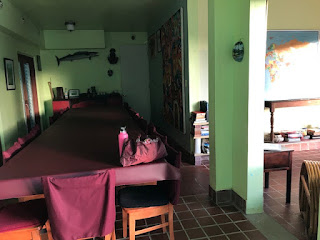My room was spacious, with 3 beds, 2 little desks, a ceiling
fan, and a bathroom with hot water. The balcony overlooked the forest and
cascade that sits below the lodge, and had a little table and chairs. It was very
relaxing to hear the coqui frogs and cascade at night. I brought food for my
lunch and dinner as the
closest place for meals was 20 minutes away (the town of Naguabo off Hwy 53 has
gas, grocery store, and restaurants). The kitchen has a large refrigerator for
guests to use. They will make lunches for guests for $10, either to take on a hike or eat at the hotel.
Breakfast isn't served until 9am, so I missed it
the first morning as I hired a guide for birding. The 2nd morning I
got to see what I missed out on – a family-style breakfast with the other
guests, with lots of fruit, juice, and coffee, and wonderful oatmeal, eggs, and
hash browns made by the owner.
Casa Cubuy is in the national forest and has a short path to
the cascade below that has pools deep enough for swimming. The road past the
lodge gave me a chance to do some birding, and I heard that at the end of the
road are paths into the forest. Unfortunately my stay wasn’t long enough to
explore those.
The only drawback to Casa Cubuy was the 40 minute drive back
to the area that had beaches and more parks and tourist attractions (around Fajardo).
A longer stay at the casa would have been ideal, with a couple day-trips to other
attractions. Also I am an early morning person so waiting until 9am for
breakfast was inconvenient, so worth a longer stay to have mornings to enjoy
that.
Here are the birds I saw just from the road, with links to
eBird. Also, I was told the guesthouse downhill has hummingbirds.












